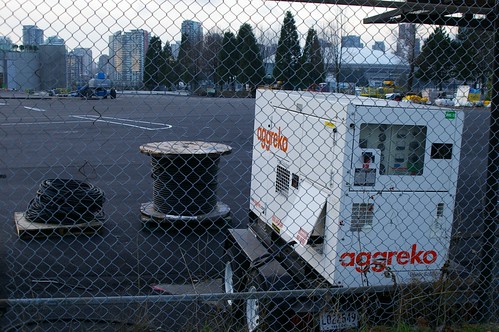Large events like the Olympics often require temporary structures and temporary power for those structures. This was certainly the case at the Torino Olympics where over 500 generators burnt around 8,000,000 litres of fuel.
BC Hydro and VANOC promised that the 2010 Olympics would be different - it would be using BC Hydro's clean power sources and reduce GHG emissions by 90%. But, apparently they weren't able to completely give up on the generators.
Aggreko, the official supplier of diesel pollution for the games, is bragging that they will be supplying 34 MW of generators and 31 MW of electric heat. Which based on my calculations is more than 10% of the amount used in Torino (so much for the 90% reduction).
One might expect that most of this generation was in the remote mountain venues. But the diesel generator pictured here is just one of several found at the Athlete's Village in the heart of Vancouver. And this is not a back-up generator. It appears to be running 24/7.


BC Hydro and VANOC promised that the 2010 Olympics would be different - it would be using BC Hydro's clean power sources and reduce GHG emissions by 90%. But, apparently they weren't able to completely give up on the generators.
Aggreko, the official supplier of diesel pollution for the games, is bragging that they will be supplying 34 MW of generators and 31 MW of electric heat. Which based on my calculations is more than 10% of the amount used in Torino (so much for the 90% reduction).
One might expect that most of this generation was in the remote mountain venues. But the diesel generator pictured here is just one of several found at the Athlete's Village in the heart of Vancouver. And this is not a back-up generator. It appears to be running 24/7.
And VANOC and the City of Vancouver were thoughtful enough to re-route a popular bike route to run right past this pollution source.






No comments:
Post a Comment